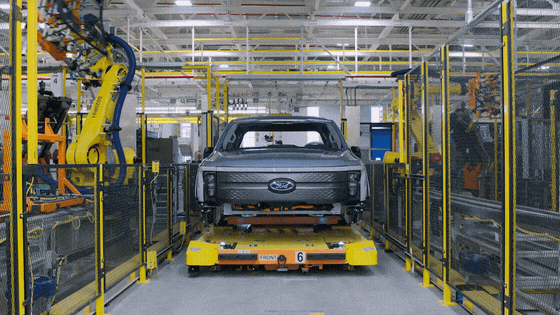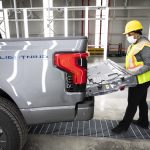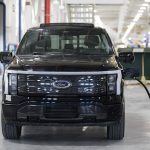Ford continues to put its money where its mouth is when considering its transition to electrification. Today, Ford announced it has launched pre-production of the F-150 Lightning, the company’s all-electric version of the U.S.’ most popular pickup at the Dearborn, Michigan, assembly plant. Additionally, the company announced it will invest an additional $250 million into electric vehicle employment and production efforts.
“As the first pre-production F-150 Lightning trucks roll out of Ford’s new Rouge Electric Vehicle Center and demand soars for the all-electric truck, Ford today said it will increase investment and add jobs to boost production,” the company said in a press release earlier today. Ford has already invested $7.7 billion in Michigan in the past 5 years but plans to funnel an additional $250 million into EVs, hoping that it will provide 450 more direct jobs at the Rouge Electric Vehicle Center, Van Dyke Electric Powertrain Center, and the Rawsonville Components Plant.
Many of the 450 additional jobs will provide workers with the task of assembling the F-150 Lightning at the Rouge Electric Vehicle Center. “I am proud of Ford for committing to invest $30 billion in electrification through 2025, including this additional $250 million today to create 450 jobs in Dearborn, Ypsilanti and Sterling Heights supporting the production of the new F-150 Lightning,” Michigan Governor Gretchen Whitmer said.
- One year after Ford confirmed construction of the Rouge Electric Vehicle Center in Dearborn, Mich., the first Ford F-150 Lightning pre-production units begin leaving the factory. Pre-production model shown. F-150 Lightning available starting spring 2022.
- One year after Ford confirmed construction of the Rouge Electric Vehicle Center in Dearborn, Mich., the first Ford F-150 Lightning pre-production units begin leaving the factory. Pre-production model shown. F-150 Lightning available starting spring 2022.
- One year after Ford confirmed construction of the Rouge Electric Vehicle Center in Dearborn, Mich., the first Ford F-150 Lightning pre-production units begin leaving the factory. Pre-production model shown. F-150 Lightning available starting spring 2022.
- One year after Ford confirmed construction of the Rouge Electric Vehicle Center in Dearborn, Mich., the first Ford F-150 Lightning pre-production units begin leaving the factory. Pre-production model shown. F-150 Lightning available starting spring 2022.
- Credit: Ford Motor Company
The investment will also help Ford reach its 80,000 unit production rate of the F-150 Lightning. Ford originally planned to produce 40,000 of the trucks every year but recently doubled its annual production rate following a massive number of pre-orders for its first all-electric pickup.
Images of the F-150 Lightning rolling off of production lines were released today. Ford plans to begin production and delivery of the F-150 Lightning in the Spring, but pre-production units are usually utilized by the automaker for several reasons. Ford could take these units to events or showrooms, or it could crash them in safety tests that will be performed within the next few months.
One year after Ford confirmed construction of the Rouge Electric Vehicle Center in Dearborn, Mich., the first Ford F-150 Lightning pre-production units begin leaving the factory. Pre-production model shown. F-150 Lightning available starting spring 2022.
The demand for the F-150 Lightning seems to have surprised Ford Executive Chair Bill Ford. “We knew the F-150 Lightning was special, but the interest from the public has surpassed our highest expectations and changed the conversation around electric vehicles. So we are doubling down, adding jobs and investment to increase production,” Ford said. “This truck and the Ford-UAW workers who are assembling it in Michigan have a chance to make history and lead the electric vehicle movement in America.”
Ford F-150 Lightning unveiled: Price, Release date, Range, Features and more
The truck will start at only $40,000, which is less than the average cost of a new car in the U.S., according to Kelley Blue Book. Additionally, the F-150 Lightning will offer around 300 miles of range with its optional extended battery. The truck has already accumulated over 150,000 pre-orders.
“F-150 Lightning is intended to be more than a no-compromise zero tailpipe-emissions truck. It’s packed with ingenious features and technology that will improve over time, it’s exhilarating to drive and it can power your home and worksite,” Ford’s President of the Americas and International Markets Group, Kumar Galhotra, said.
Don’t hesitate to contact us with tips! Email us at tips@teslarati.com, or you can email me directly at joey@teslarati.com.

Elon Musk
Elon Musk and Tesla AI Director share insights after empty driver seat Robotaxi rides
The executives’ unoccupied tests hint at the rapid progress of Tesla’s unsupervised Robotaxi efforts.

Tesla CEO Elon Musk and AI Director Ashok Elluswamy celebrated Christmas Eve by sharing personal experiences with Robotaxi vehicles that had no safety monitor or occupant in the driver’s seat. Musk described the system’s “perfect driving” around Austin, while Elluswamy posted video from the back seat, calling it “an amazing experience.”
The executives’ unoccupied tests hint at the rapid progress of Tesla’s unsupervised Robotaxi efforts.
Elon and Ashok’s firsthand Robotaxi insights
Prior to Musk and the Tesla AI Director’s posts, sightings of unmanned Teslas navigating public roads were widely shared on social media. One such vehicle was spotted in Austin, Texas, which Elon Musk acknowleged by stating that “Testing is underway with no occupants in the car.”
Based on his Christmas Eve post, Musk seemed to have tested an unmanned Tesla himself. “A Tesla with no safety monitor in the car and me sitting in the passenger seat took me all around Austin on Sunday with perfect driving,” Musk wrote in his post.
Elluswamy responded with a 2-minute video showing himself in the rear of an unmanned Tesla. The video featured the vehicle’s empty front seats, as well as its smooth handling through real-world traffic. He captioned his video with the words, “It’s an amazing experience!”
Towards Unsupervised operations
During an xAI Hackathon earlier this month, Elon Musk mentioned that Tesla owed be removing Safety Monitors from its Robotaxis in Austin in just three weeks. “Unsupervised is pretty much solved at this point. So there will be Tesla Robotaxis operating in Austin with no one in them. Not even anyone in the passenger seat in about three weeks,” he said. Musk echoed similar estimates at the 2025 Annual Shareholder Meeting and the Q3 2025 earnings call.
Considering the insights that were posted Musk and Elluswamy, it does appear that Tesla is working hard towards operating its Robotaxis with no safety monitors. This is quite impressive considering that the service was launched just earlier this year.
Elon Musk
Starlink passes 9 million active customers just weeks after hitting 8 million
The milestone highlights the accelerating growth of Starlink, which has now been adding over 20,000 new users per day.

SpaceX’s Starlink satellite internet service has continued its rapid global expansion, surpassing 9 million active customers just weeks after crossing the 8 million mark.
The milestone highlights the accelerating growth of Starlink, which has now been adding over 20,000 new users per day.
9 million customers
In a post on X, SpaceX stated that Starlink now serves over 9 million active users across 155 countries, territories, and markets. The company reached 8 million customers in early November, meaning it added roughly 1 million subscribers in under seven weeks, or about 21,275 new users on average per day.
“Starlink is connecting more than 9M active customers with high-speed internet across 155 countries, territories, and many other markets,” Starlink wrote in a post on its official X account. SpaceX President Gwynne Shotwell also celebrated the milestone on X. “A huge thank you to all of our customers and congrats to the Starlink team for such an incredible product,” she wrote.
That growth rate reflects both rising demand for broadband in underserved regions and Starlink’s expanding satellite constellation, which now includes more than 9,000 low-Earth-orbit satellites designed to deliver high-speed, low-latency internet worldwide.
Starlink’s momentum
Starlink’s momentum has been building up. SpaceX reported 4.6 million Starlink customers in December 2024, followed by 7 million by August 2025, and 8 million customers in November. Independent data also suggests Starlink usage is rising sharply, with Cloudflare reporting that global web traffic from Starlink users more than doubled in 2025, as noted in an Insider report.
Starlink’s momentum is increasingly tied to SpaceX’s broader financial outlook. Elon Musk has said the satellite network is “by far” the company’s largest revenue driver, and reports suggest SpaceX may be positioning itself for an initial public offering as soon as next year, with valuations estimated as high as $1.5 trillion. Musk has also suggested in the past that Starlink could have its own IPO in the future.
News
NVIDIA Director of Robotics: Tesla FSD v14 is the first AI to pass the “Physical Turing Test”
After testing FSD v14, Fan stated that his experience with FSD felt magical at first, but it soon started to feel like a routine.

NVIDIA Director of Robotics Jim Fan has praised Tesla’s Full Self-Driving (Supervised) v14 as the first AI to pass what he described as a “Physical Turing Test.”
After testing FSD v14, Fan stated that his experience with FSD felt magical at first, but it soon started to feel like a routine. And just like smartphones today, removing it now would “actively hurt.”
Jim Fan’s hands-on FSD v14 impressions
Fan, a leading researcher in embodied AI who is currently solving Physical AI at NVIDIA and spearheading the company’s Project GR00T initiative, noted that he actually was late to the Tesla game. He was, however, one of the first to try out FSD v14.
“I was very late to own a Tesla but among the earliest to try out FSD v14. It’s perhaps the first time I experience an AI that passes the Physical Turing Test: after a long day at work, you press a button, lay back, and couldn’t tell if a neural net or a human drove you home,” Fan wrote in a post on X.
Fan added: “Despite knowing exactly how robot learning works, I still find it magical watching the steering wheel turn by itself. First it feels surreal, next it becomes routine. Then, like the smartphone, taking it away actively hurts. This is how humanity gets rewired and glued to god-like technologies.”
The Physical Turing Test
The original Turing Test was conceived by Alan Turing in 1950, and it was aimed at determining if a machine could exhibit behavior that is equivalent to or indistinguishable from a human. By focusing on text-based conversations, the original Turing Test set a high bar for natural language processing and machine learning.
This test has been passed by today’s large language models. However, the capability to converse in a humanlike manner is a completely different challenge from performing real-world problem-solving or physical interactions. Thus, Fan introduced the Physical Turing Test, which challenges AI systems to demonstrate intelligence through physical actions.
Based on Fan’s comments, Tesla has demonstrated these intelligent physical actions with FSD v14. Elon Musk agreed with the NVIDIA executive, stating in a post on X that with FSD v14, “you can sense the sentience maturing.” Musk also praised Tesla AI, calling it the best “real-world AI” today.















